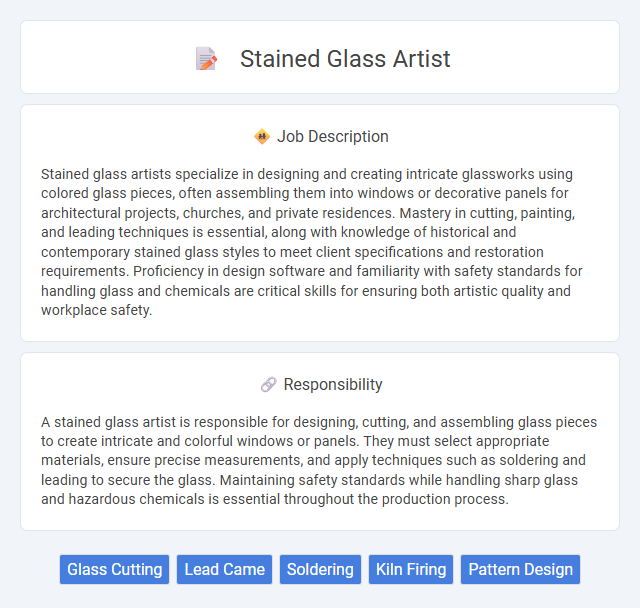
Stained glass artists specialize in designing and creating intricate glassworks using colored glass pieces, often assembling them into windows or decorative panels for architectural projects, churches, and private residences. Mastery in cutting, painting, and leading techniques is essential, along with knowledge of historical and contemporary stained glass styles to meet client specifications and restoration requirements. Proficiency in design software and familiarity with safety standards for handling glass and chemicals are critical skills for ensuring both artistic quality and workplace safety.
People with strong attention to detail and a passion for art are likely well-suited for a stained glass artist job, as it requires precision and creativity. Individuals who enjoy working with their hands and have patience for meticulous tasks may also find this role fulfilling. Those prone to frustration or lacking fine motor skills might face challenges in this profession.
Qualification
Stained glass artists must possess a combination of artistic talent and technical skills, often gained through formal education in fine arts or specialized glasswork programs. Proficiency in color theory, design principles, and knowledge of glass cutting, soldering, and leading techniques are essential qualifications. Experience with software for design visualization and a strong portfolio showcasing craftsmanship significantly enhance job prospects.
Responsibility
A stained glass artist is responsible for designing, cutting, and assembling glass pieces to create intricate and colorful windows or panels. They must select appropriate materials, ensure precise measurements, and apply techniques such as soldering and leading to secure the glass. Maintaining safety standards while handling sharp glass and hazardous chemicals is essential throughout the production process.
Benefit
Stained glass artists likely experience a high degree of creative fulfillment through designing and crafting unique, colorful works that transform light and space. The job probably offers opportunities to collaborate on architectural projects, enhancing both historical preservation and modern aesthetics. Financial benefits may include commission-based earnings and potential demand in niche markets such as religious institutions and custom home installations.
Challenge
The stained glass artist job likely involves intricate challenges related to precision cutting and assembling delicate glass pieces to create vivid designs. Ensuring color consistency and structural integrity may present ongoing difficulties, requiring careful attention to detail and steady craftsmanship. The probability of encountering physical strain or safety hazards, such as handling sharp materials, could necessitate strict adherence to safety protocols.
Career Advancement
Stained glass artists who refine their skills and develop a distinctive artistic style can advance to leadership roles such as studio director or workshop manager. Building a strong portfolio and establishing connections with galleries, architects, and interior designers enhances opportunities for commissioned projects and exhibitions. Continuous education in new glass techniques and collaboration with industry professionals also contributes significantly to career growth in this creative field.
Key Terms
Glass Cutting
Stained glass artists specialize in precision glass cutting to create intricate patterns and designs essential for assembling vibrant stained glass windows. Mastery in using tools like glass cutters, grozing pliers, and grinders ensures clean edges and precise shapes that fit seamlessly within lead or copper foil frameworks. Expertise in selecting appropriate glass types and thicknesses enhances both the aesthetic appeal and structural integrity of each stained glass piece.
Lead Came
A stained glass artist specializing in Lead Came expertly joins glass pieces using lead strips, creating detailed and durable window designs. Mastery in shaping and soldering Lead Came ensures structural integrity while enhancing intricate patterns and vibrant colors. Precision and artistic skill are essential for crafting both traditional and contemporary stained glass artworks with this technique.
Soldering
Stained glass artists utilize soldering to join individual glass pieces, ensuring structural integrity and seamless design. Mastery of soldering techniques, such as flux application and temperature control, is crucial for creating durable, high-quality stained glass panels. Precision in soldering enhances both the aesthetic appeal and longevity of stained glass artworks.
Kiln Firing
Kiln firing is a crucial process for stained glass artists, as it strengthens and fuses glass pieces, ensuring durability and vibrant color retention. Artists carefully control temperature and timing in the kiln to prevent cracking and achieve precise color effects in their designs. Mastery of kiln firing techniques enhances the quality and longevity of stained glass artwork.
Pattern Design
Stained glass artists specializing in pattern design create intricate, visually captivating motifs that enhance the aesthetic appeal of windows and decorative panels. Their expertise involves selecting color palettes, shaping glass pieces, and arranging patterns to achieve harmonious light diffusion and storytelling effects. Mastery in drafting detailed templates and knowledge of historical and contemporary design trends are essential for producing unique, durable stained glass artworks.
 kuljobs.com
kuljobs.com